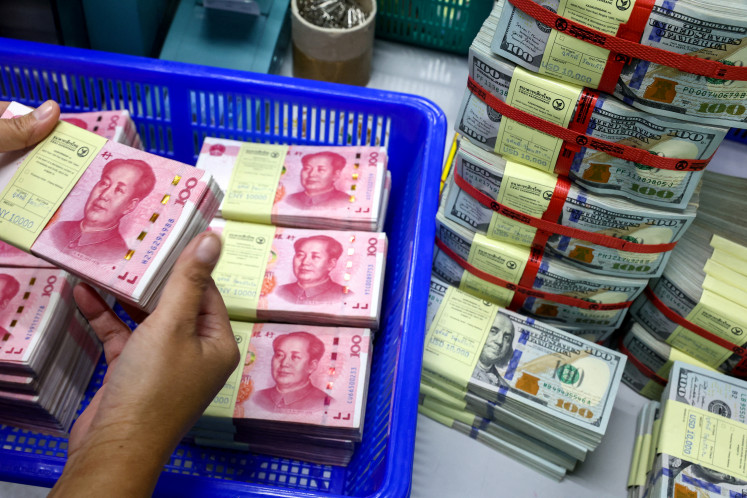Pucung craftsmen turning skin into puppets
Getting ready: A puppet is examined at a handicraft shop in Pucung hamlet, Bantul regency, Yogyakarta before being sold
Change text size
Gift Premium Articles
to Anyone

Getting ready: A puppet is examined at a handicraft shop in Pucung hamlet, Bantul regency, Yogyakarta before being sold. JP/Tarko Sudiarno
When the days are hot, bad smells linger in every corner of Pucung hamlet in Bantul regency, Yogyakarta. The smells come from the skins of goats, cows and buffaloes put under the sun to dry.
Originally, the villagers used the skins to make puppets. A large number of residents in the hamlet depended on their puppet-making skills for their livelihoods. Pucung is known as the kampong of puppet makers.
“Almost all the villagers rely on puppets for their living. Everyone can make puppets, starting from children up to old people, men and women,” said Brahim, 65, one of
the craftsmen.
Brahim is part of the third generation of puppet craftsmen in his family. He said the craft reached its peak in 1980s.
At that time, they were not able to meet the overwhelming orders for puppets, both for decorations and performance.
But the puppet-making business started to decline as people became more glued to the television. In children’s eyes, puppet characters were eclipsed by super heroes, such as Naruto, Superman and Spiderman, on the screen.
This change forced Pucung craftsmen to adapt, in order to survive. Today, they do not only create puppets, but they are craftsmen in the art of calligraphy and painting, making several souvenirs.
Jumakit is one of the craftsmen. Apart from producing gapitan puppets for shadow-puppet performances, he also produces other crafts, including paintings on animal skins.
For one decorative puppet, the price varies between Rp 25,000 (US$2) and Rp 750,000 each. “If it has been framed and the size is rather big, the price is between Rp 250,000 and Rp 750,000,” Jumakit said.
Another craftsman, Suradi, is currently focussing on calligraphy. In one month Suradi, together with dozens of his workers, is able to produce 1,000 works of calligraphy that are exported to Greece.
One calligraphy work costs between Rp 30,000 and Rp 100,000, depending on the size and degree of intricacy. Suradi’s monthly turnover sometimes reaches Rp 100 million.
The innovation of Pucung craftspeople has spread the name of Pucung’s products all over the world. Apart from sales in the local market, a large number of Pucung’s products are exported abroad to Japan, Australia, the United States, Europe and the Middle East.
Although the product innovation keeps going, the craftsmen have not completely abandoned puppet making.
Brahim keeps producing puppets even though the demand for them has weakened. He can produce one puppet a day, which he sells this for Rp 25,000.
“Although I’m not as busy as I was before, I always make puppets,” he said.
Suradi has also stuck to producing puppets. The father of three children did not want to abandon the craft because, according to him, puppets carry a good moral message.
The craftsmen use traditional methods to create their puppets.
The animal is skinned and the skin is washed in the river. To ensure that the skins have a long life, the villagers soak the skins for a week in limestone before drying them under the sun. The skins are then processed using traditional equipments, not machines.
All parts of the goat or cow skins are useful. The skin that is trimmed off is used to make goods that also have an economical value. This includes fans, bookmarks, pencil holders and wedding souvenirs.
According to the community, the history of Pucung as a pioneer of animal skin handcrafts started with the arrival of Atmokaryo, a high-ranking servant of the Yogyakarta Palace, in the 1940s. Atmokaryo, who lived in Pucung, was able to make puppets and often received orders from the palace.
To fulfil the orders Atmokaryo taught his craft to the villagers. The puppet orders started to flow in from various parties, and a large number of villagers became involved. Slowly but surely the craft spread, creating an independent livelihood for a large number of villagers.
They kept going despite many disasters.
The first Bali bombings in 2002 ruined a large part of the Pucung business because a large number of people relied on selling their products in Bali.
After the drop in demand following the bombings, the number of craftsmen decreased from 500 to 150 people.
“Before the bombings, I exported a minimum of one container every three months. But after the Bali bombings, I totally stopped exporting and could only rely on the Javanese market,” Jumakit said.
They were about to start developing local markets and exporting handicrafts to the Middle East,
but the 2006 earthquake hit the province, shattering their businesses again.
The earthquake ruined their houses and their workshops. A number of craftsmen changed
jobs, becoming construction workers or tradesmen to support their families.
Now, with a Rp 1 billion loan from the Yogyakarta government, the Pucung craftsmen are getting back on their feet again.









